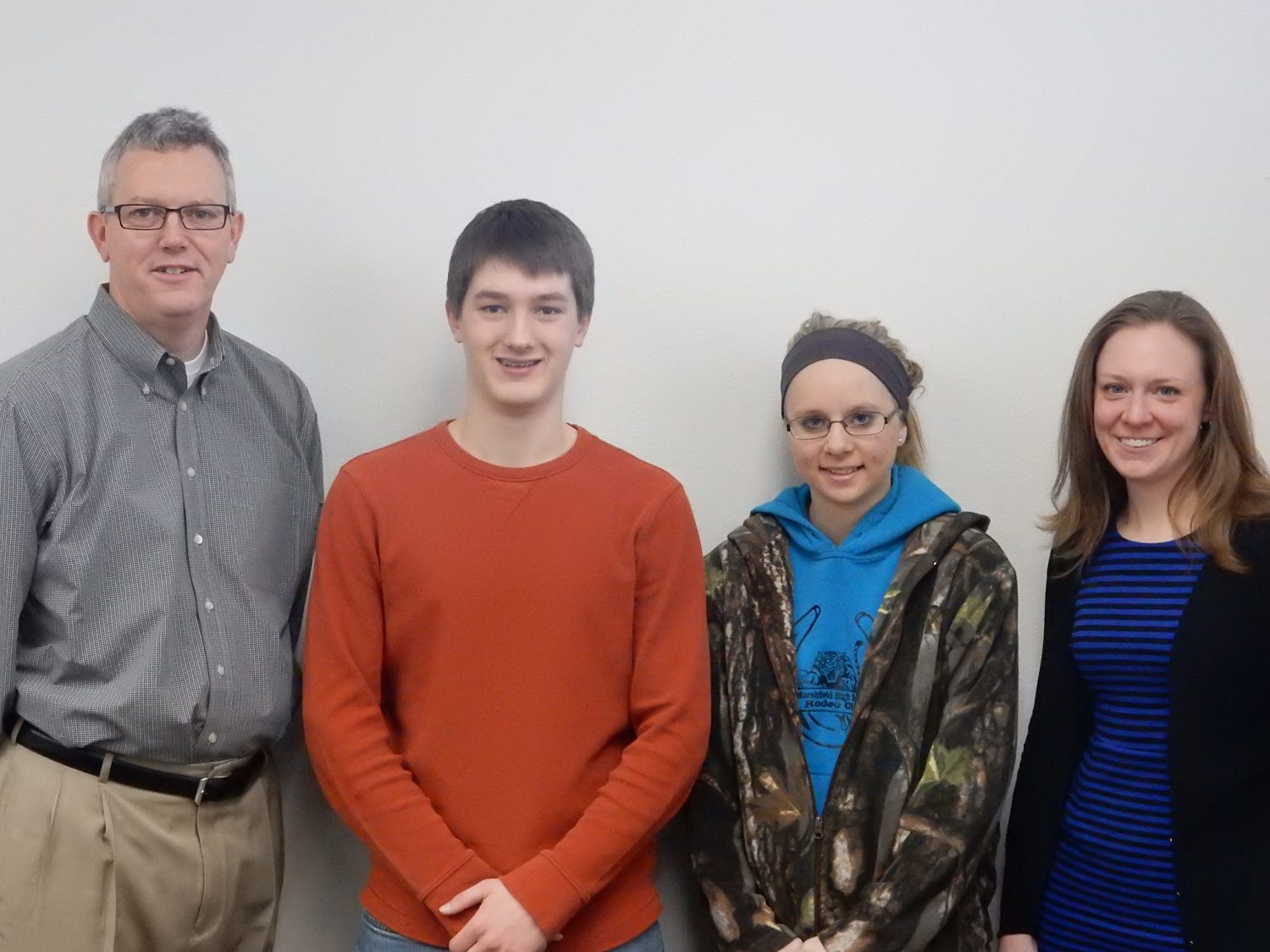The science of it all

By Mike Warren
MARSHFIELD – A unique science class has Marshfield High School students analyzing the world around them.
Students in Amy Fassler’s Advanced Placement Environmental Science class had a chance to present their most-recent findings, during a Dec. 15 after-school “poster session” for other teachers and students at MHS.
“The project-based learning model has really allowed students to dig into a topic that is of interest to them,” Fassler said. “The students have gotten a lot out of listening to other students talk about their project and asking them questions. The students feel that the projects give them a good opportunity to connect a lot of different topics in their study of environmental science.”
At least one of those topics has junior Monet Veers looking into the giant invasive hogweed she found right next to a relative’s central Wisconsin farm field.

Carly Winder and Richard Gui look on, as fellow students Will Jepsen and Henry Johnson present the findings of their AP Environmental Science class project “How Does the Area of a Habitat Influence Species Diversity?” Dec. 15 at Marshfield High School.
“We have what we think are probably hogweed just down the road from my house. We counted a few hundred plants,” she said.
According to the poster Veers prepared for her presentation as part of the class, “the land adjacent to the potentially-infested area is used for agriculture. Given that the presence of Giant Hogweed decreases the overall health of the soil, identification and control will be crucial for area farmers and their crops.”
Veers said hogweed is no picnic for humans, either.
“Hogweed sap will get on your skin, and it’ll be fine until you go in the sun. The sun hits the sap, and it can give you third-degree burns,” she added.
The U.S. has now classified the invasive plant as a noxious weed.
Fassler’s “science experiment” had other students studying the environment just beyond the walls of their classroom.
In a project called “War on Marine Life,” juniors Sophia Soskos and Julia Kumm “tested the phosphate and nitrate levels in the wetlands pond behind our Marshfield High School and the stream at Braem Park.” according to Soskos.
“We also tested dissolved oxygen levels,”Kumm added. “We find that when there’s more nutrients, like phosphates and nitrates, in the water, there’s going to be less dissolved oxygen, and this is because of eutrophication, which is excess nutrients in the water. This causes algal blooms. When the algae dies, the bacteria consumes dissolved oxygen and kills animals and marine life in the water system.”
Soskos and Kumm were able to correlate what they found locally with excessive nitrate and phosphate runoff into the Gulf of Mexico, causing “dead zones” with a lack of dissolved oxygen, which is now having a direct economic impact on a decline in seafood production and tourism, not to mention an explosion of harmful algal bloom toxins which pose a human health risk.
Sophomore Carly Winder’s project posed the question, “What’s Killing the Bees?”
“A combination of Varroa mites, fungicide and habitat loss,” Winder said as she explained her project and poster to a group of parents and teachers. Winder studied the declining honeybee population, both nationally and internationally, and possible ways to reverse the trend.
Another group of students tackled the idea of tracing ivory to prevent the poaching of African elephants.
“Our experiment was based off of a previous experiment in which they took ivory samples and conducted DNA analysis to locate where there were higher-than-normal rates of elephant poaching”, explained Ruhi Shah. “From there, they were able to come up with solutions to potentially limit the increasing rate.”
Shah added the group’s main question for the experiment was how tracking the origin of ivory in Africa could prevent future elephant poaching.
“The main identifiable variable to differentiate between the ivory is called short tandem repeats,” according to group member Sydney Newmier.“When we looked at the DNA, we separated them into different fragments of DNA to determine where the ivory came from. So, these short tandem repeats are non-coding DNA segments, and that’s how they determine the difference between the elephant species and where they came from.”
The third member of the group, Ava Sainterme, added, “Our general goal was to use this DNA to compare these fragments to those in the existing database. We used that to track the population of elephants and which country they came from, to determine where the highest rates of poaching were.”
The duo of Henry Johnson and Will Jepsen looked at how the area of a habitat influences species diversity.
“As humans use up more land, the amount of available resources for animals decreases”, according to their project poster. “Our findings can help ecologists plan for and create large enough habitat islands.”
“They’ve all done two projects so far this year,” says Fassler, “and they’ll do a total of probably six.
“It has been great for me as an instructor to work with students to do the process of asking good science questions, designing an experiment, and helping them analyze their data.”






